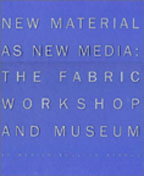New Material as New Media: The Fabric Workshop and Museum
By Marion Boulton Stroud $50.00 328 pp. Cloth 270 illustrations, 268 Color Reviewed by Gwendolyn Holbrow This sumptuous volume, with multicolored satin covers, gilt-edged pages and transparent dust jacket, reflects in both form and content the innovative use of materials promoted by its subject, the Fabric Workshop and Museum (FW + M) in Philadelphia. Published to accompany a 25th anniversary retrospective show, it celebrates both what has gone into the FW + M and what has come out during the past quarter century. Both input and output have been nothing short of extraordinary. Founded in 1977 and directed ever since by Marion Stroud, the original mission of the Fabric Workshop was to provide student internships and artist residencies for creating repeat fabric yardage. Participating artists, backed by Stroud, promptly pushed back the boundaries, stretching fabric into fabrication. As Stroud says in an interview at the front of the book, “Our practice has been to follow the artists, to let them take the lead. I believe their intuition is amazing. They hear the tremor of the earthquake before the earthquake comes.” This support has attracted over 450 artists to residencies at the FW + M, from emerging to names like Claes Oldenburg, Faith Ringgold and Kiki Smith. The result is such a spectacular collection of contemporary art that, in 1996, “Museum” was added to the name. The book showcases the work of more than fifty artists, working in a tremendous range of materials, from printed fabrics in the early days (Roy Lichtenstein, Robert Venturi), through hog intestines (Miroslaw Balka), spider silk (Christine Borland), and knitted stainless steel (Jana Sterbak), to fiberglass karaoke pods (Lee Bul) and video installation (Bill Viola, Marina Abramović). The artists are arranged alphabetically, each represented by a single page of text followed by several pages of enormous (13 x 10 ¾”) beautifully printed full-color photographs: a pleasing ratio, as the work speaks eloquently for itself. Scattered throughout are essays by curators and art historians associated with the FW + M. Robert Storr says of his part in a 1992 performance piece by Louise Bourgeois, “…the performers were instructed to dress in their underwear over which were buttoned or hung various skirts and jackets embroidered in red thread with other texts, for example, ‘Fear makes the world go round,’ It does of course, and while the artist’s original plan had been for us to wear nothing underneath these garments, fear—coupled in my case with the concern that the unwarned public not be exposed to a middle-aged man with nothing to hide but nothing to show off either—overruled her wishes.” Arthur Danto expounds on the inherent meaning of materials, and Larry Rinder describes a collaborative project of the FW + M with the Maisin tribe of Papua New Guinea. The book flies off in multiple directions, and might have benefited from presenting the works chronologically rather than alphabetically. That’s a minor quibble, though. As Storr says, “The Fabric Workshop and Museum’s scope is as wide as contemporary art itself, and its role is that of a patron of some of the liveliest talents active today. All in all, something to celebrate!” This book is a splendid invitation to the party. |